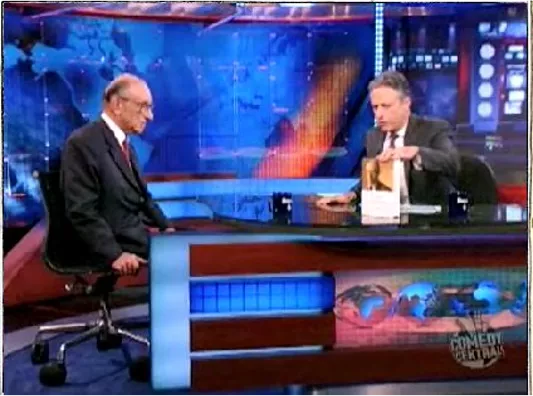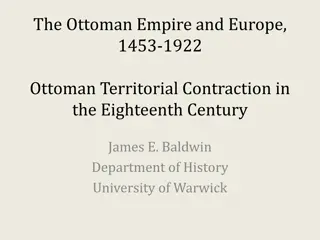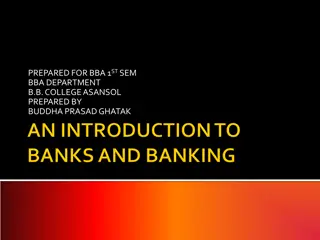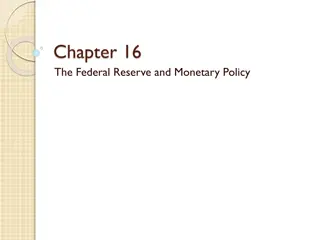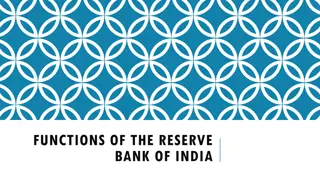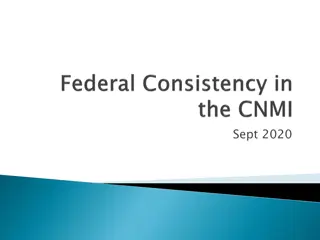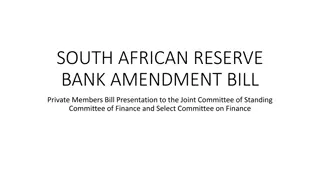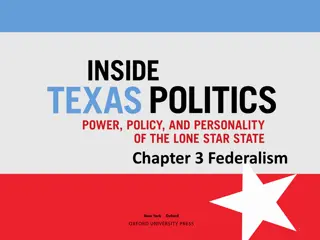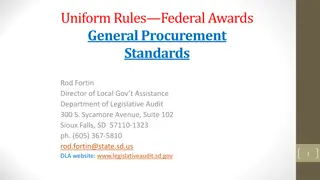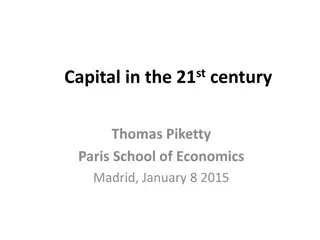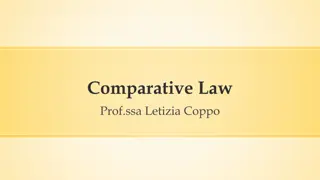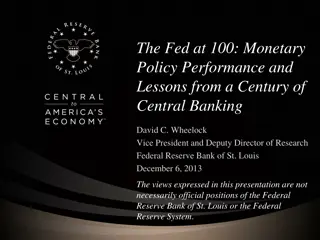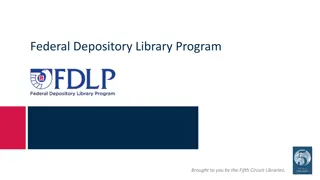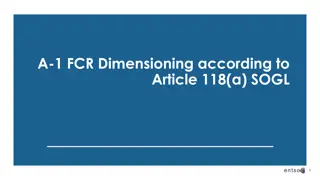Evolution of the Federal Reserve System: A Century of Impact
Explore the establishment of the Federal Reserve, the role of the central bank in a free-market economy, pre-Fed era panics, policies affecting national banks, reform discussions, and the pivotal Federal Reserve Act of 1913, shaping the financial landscape of the United States.
Download Presentation

Please find below an Image/Link to download the presentation.
The content on the website is provided AS IS for your information and personal use only. It may not be sold, licensed, or shared on other websites without obtaining consent from the author. Download presentation by click this link. If you encounter any issues during the download, it is possible that the publisher has removed the file from their server.
E N D
Presentation Transcript
A CENTURY OF THE FEDERAL RESERVE: SUCCESS OR FAILURE? Lawrence H. White George Mason U. Foundation for Teaching Economics 23 April 2015 00:50
WHY WAS THE FEDERAL RESERVE ESTABLISHED? Many people are free- market capitalists, and they always talk about free-market capitalism, and that is our economic theory. So why do we have a Fed? Is the free market wouldn t the market take care of interest rates and all that? Daily Show, 18 Sept. 2007 01:04
WHY WAS THE FEDERAL RESERVE ESTABLISHED? You re raising a very fundamental question. You didn t need a central bank when we were on the gold standard, which was back in the nineteenth century. And all of the automatic things occurred because people would buy and sell gold, and the market would do what the Fed does now. Note: Because the US was on the gold std. in 1913 when the Fed Reserve Act was passed. Daily Show, 18 Sept. 2007 03:00
PANICS OF THE PRE-FED ERA Milder in 1884, 1890 More severe in 1873, 1893, and 1907 widespread suspensions, runs currency famine Run- and panic-proneness of US banks not natural, but due to policies that weakened US banks No such problems in Canada Panic of 1907, NYC 03:40
POLICIES THAT WEAKENED NATIONAL BANKS restrictions on branching (contrast Canada) poorly diversified banks failure-prone run-prone collateral restrictions on note-issue (contrast Canada) seasonal demands led to reserve drains banks couldn t issue more notes to swap for deposits even in a currency famine Image:US $5 2nd Charter Period National Bank Note.jpg 06:20
REFORM DISCUSSED BUT NOT ADOPTED Deregulation a la Canada: ABA s 1894 Baltimore Plan end bond-collateral restriction on note-issue branch banking to provide speedier drain for excess notes opposed by small banks 07:30
INSTEAD OF DEREGULATION: THE FEDERAL RESERVE ACT, 1913 To provide for the establishment of Federal reserve banks, to furnish an elastic currency, to afford means of rediscounting commercial paper, to establish a more effective supervision of banking in the United States, and for other purposes. 08:40
FEDERAL RESERVE ACT NATIONALIZED 3 KEY CLEARINGHOUSE ROLES bankers banks for interbank payments: check clearing and settlement lender of last resort seasonal and emergency elasticity to currency, reserves supervision of member banks 10:50
THE FED ASSUMED TWO ADDITIONAL KEY ROLES Conducting an active monetary policy (during WWI) FR Act assumed that gold standard will determine money supply Monopoly of paper currency issue (during the 1930s) National Banks continued to issue notes until then 12:10 1929 notes
PRE-FED PERIOD VS. FED DURING WWI: PRICE INDEX FOR 10 INDUSTRIAL AND AGRICULTURAL COMMODITIES 13:10
THE FED 1ST DECADE, 1914-24: 20+% INFLATION, THEN SHARP (PARTIAL) CORRECTION WWI 14:10
(RECOMMENDED) 14:40
THE FED 2ND DECADE, 1924-34: BOOM, BUST, GREAT CONTRACTION WITH 10% DEFLATION Great Contraction Boomends Gold confiscation, devaluation 19:55
WHY DID THE FED FAIL SO BADLY TO PREVENT THE GREAT CONTRACTION? Bordo and Wheelock (2010): The Federal Reserve Act failed to spell out the Fed s duty in a panic created a system that depended on the competence of authorities currently in charge, rather than on a set of rules failed to reform the crisis-prone U.S. banking system to allow a more stable branch banking system, such as Canada s Friedman and Schwartz (1963): The Fed took over the roles of the private clearinghouses, then did less than they had done in 1907 to stem panics 23:00
1934-54: DEFLATION, 20% INFLATION, THE ACCORD WWII The Accord 25:30
1944: BRETTON WOODS BEGINS 1 oz. Au = $35 Harry Dexter White, John Maynard Keynes: Bretton Woods, NH, July 1944 27:50
1954-64: NOT SO BAD! THE MOST SUCCESSFUL PERIOD FOR THE FED: DUE TO BRETTON WOODS CONSTRAINT? 28:30
1971: BRETTON WOODS ENDS Pres. Richard Nixon, 8 August 1971 29:20
1964-84: THE PEACETIME GREAT INFLATION THE SECOND-GREATEST FAILURE OF THE FED BW ends Volcker appt. 30:40
AFTER 1969: WHERE DID THE PHILLIPS CURVE GO? 32:00
AFTER 1969: WHERE DID THE PHILLIPS CURVE GO? 34:35
THE TAYLOR RULE Rt= 1 + 2.5 t- 0.5yt, where Rtis current Federal Funds Rate target t is current inflation rate ytis current output gap (estimated potential real GDP minus actual real GDP, in %) A description of Fed policy 1987-2002 A norm for policy: Great Moderation while the Fed followed it Housing bubble when the Fed held R below Taylor Rule target (next slides) 36:50
12.00 The Federal Funds Rate and the Taylor Rule 10.00 R too low too long 8.00 Percent 6.00 4.00 Note: In the lecture, White mis-identifies the colors of the two lines on this graph. The gray, spikey line IS the Taylor rule projection. 2.00 0.00 Taylor Rule (Using CBO Output Gap) Federal Funds Rate 38:10 Source: FRED Database, Author's Calculations Source: L. H. White in Beckworth, ed., Boom and Bust Banking (2012)
Taylor Rule Deviations vs. Housing Boom Indicators 12% (4 Quarter Lag Year-on-Year Growth Rate) 12% 10% House Price to Personal Income Per Capita (4 Quarter Lag Year-on-Year Growth Rate) 10% 8% House Price to Rent Ratio 8% 6% 4% 6% 2% 4% 0% 2% R = 0.47 -2% 0% R = 0.42 -4% -2% -6% -4% -4% -2% 0% 2% 4% 6% -4% -2% 0% 2% 4% 6% Taylor Rule Federal Funds Rate Minus Actual Federal Funds Rate Taylor Rule Federal Fund Rate Minus Actual Federal Funds Rate 38:40 Source: L. H. White in Beckworth, ed., Boom and Bust Banking (2012)
2004-14: HOUSING BOOM, GREAT RECESSION Bernanke era 39:25
2004-14: HOUSING BOOM, GREAT RECESSION 2009 A YEAR OF DEFLATION Bernanke era 40:05
Zero interest rate policy + QE 43:10 Source: St. Louis Fed Monetary Trends, 14 April 2015
DANGERS OF INTEREST RATES TOO LOW FOR TOO LONG Failure to clear out dead wood Zombie finance, slow growth Zombie banks stay open at ultralow interest rates Zombie banks finance Zombie business firms that basically drag [other firms] into the pit. Potential growth decreases. There are all kinds of evidence of this in Japan. --William R. White, 21 July 2014 New asset-price/credit bubble, setting stage for next crisis Stock markets at record high levels W. R. White: For the G-20, the total debt the non-financial private sector climbed about 30% since the crisis. Lax fiscal discipline At ultralow rates, spendthrift governments can pile up debt painlessly When rates return to normal, danger of Greek-style debt trap 46:25
INTEREST ON EXCESS RESERVES + QE BoG press release, 6 Oct. 2008: The payment of interest on excess reserves will permit the Federal Reserve to expand its balance sheet as necessary Between the lines: without corresponding expansion in M2 or the price level Not a coincidence that IOER and QE1 began together If it didn t raise the M2 path, because sterilized by IOER, what was the point of QE? Credit allocation -- to raise relative MBS prices Disguised fiscal policy: outside the debt ceiling limit, without Congressional vote 48:30
FEDS STABILIZATION TRACK RECORD IN SUM Success requires the Fed to stabilize aggregate spending, i.e. to vary M in response to money hoarding faster than market prices adjust y steady M policy Limited ability to forecast hoarding has made changes in M growth in practice poorly timed the wrong size E.g. expansion too little, too late to stop 2009 deflation poorly timed stop-go policy Yellen Fed may tighten too little, too late to stop next upswing in inflation time 50:15
BY CONTRAST TO CLASSICAL GOLD STANDARD, THE FED HAS INCREASED THE AVG. INFLATION RATE Pre-Fed gold std., 1879-1914: -0.05% Fed, 1971-2013: 4.25% Source: Selgin, Lastrapes, White (2012) 52:00
THE FED HAS INCREASED PRICE LEVEL UNCERTAINTY Source: Selgin, Lastrapes, White (2012) Price level uncertainty: 6-year rolling std. deviation of the quarterly price level 53:20 Conditional variance of price-level forecast errors, 30-year horizon Pre-Fed Post-WWII
THE FED HAS NOT REDUCED OUTPUT VOLATILITY even though US output has become more diversified, with more fiscal automatic stabilizers, and smaller measured supply shocks In response to aggregate demand shocks, Fed has tended to enlarge deviations of output by inappropriate monetary policy Output volatility (% std. dev. from trend), Romer Quarterly GDP ests. 1869-1914 1915-2009 1915-1946 2.7 5.7 1947-2009 2.6 9.2 54:20
THE FED HAS NOT REDUCED UNEMPLOYMENT US Unemployment rate, 1869-2009 55:00
THE FED HAS NOT RAISED REAL GROWTH Source: Robert E. Lucas, Jr. (2011) 55:20
HOW MIGHT WE GET BETTER RESULTS? Bind the Fed with a weighted dual mandate i.e. make it stick to a specified Taylor Rule Bind the Fed with a single mandate Target the path of a price level exclusively Better: Target the path of nominal GDP Hayek (1931): stabilize the money stream Productivity norm: when surge in output reduces inflation, don t offset with M injections, and vice-versa End the Fed with a gold standard plus free banking If not politically feasible, at least a benchmark for Fed accountability
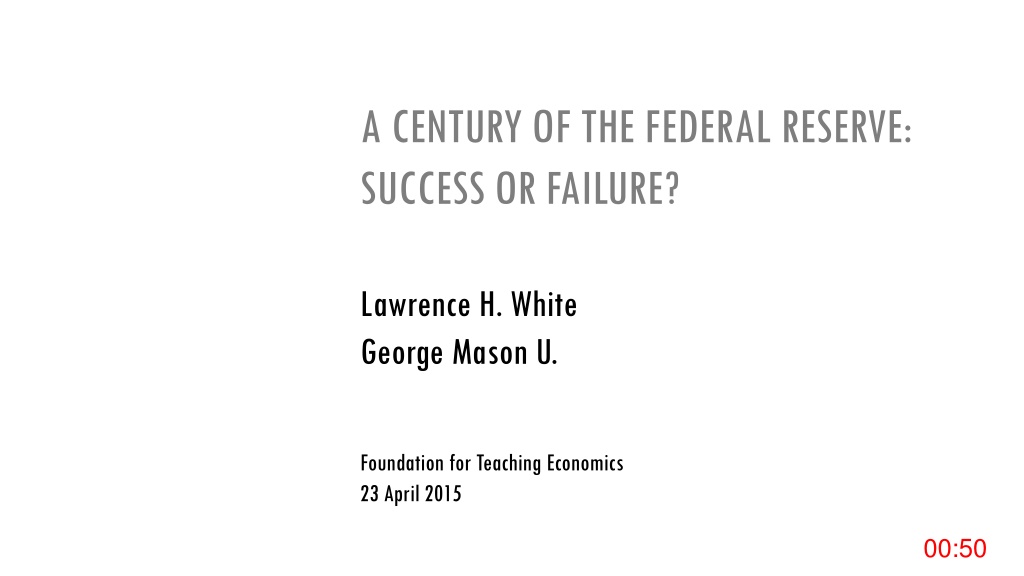
 undefined
undefined

